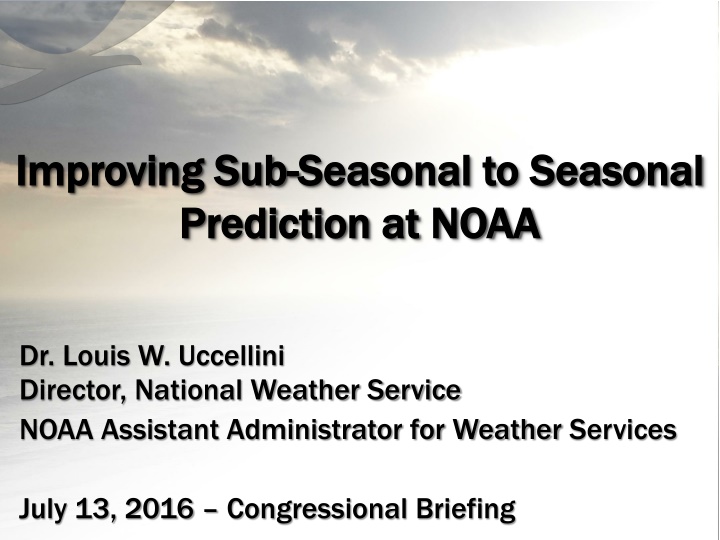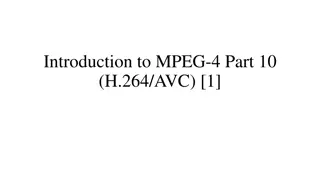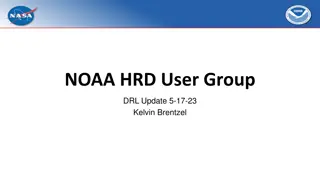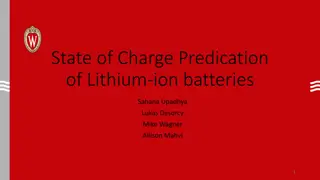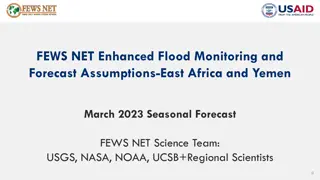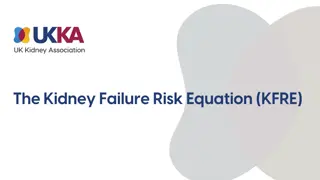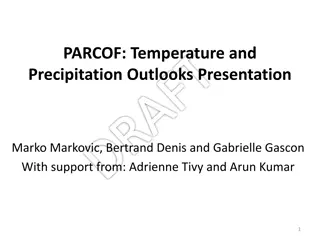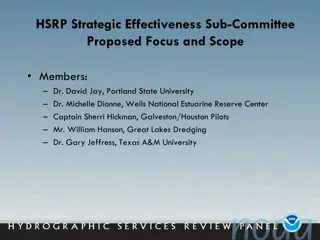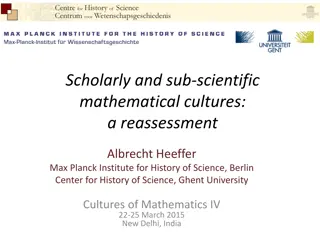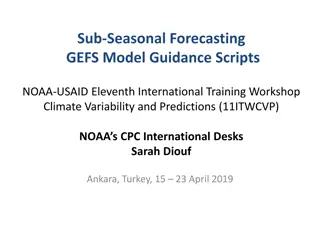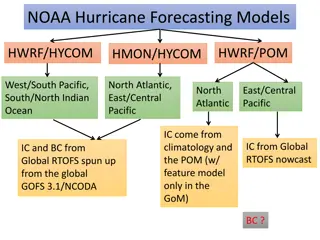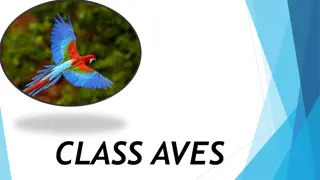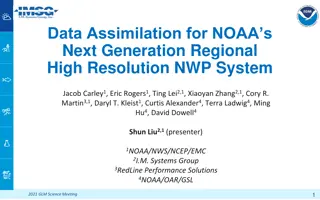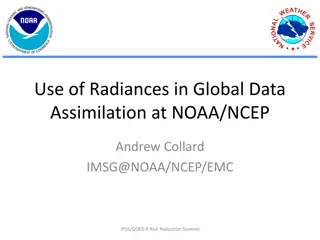Improving Sub-Seasonal to Seasonal Prediction at NOAA
NOAA's efforts in improving sub-seasonal to seasonal predictions aim to enhance emergency management planning, health outcomes, national infrastructure decisions, and national security posture. Specific initiatives include the California Drought Service Assessment, operational product development, El Niño response field campaigns, and addressing the Grand Challenge in weather prediction research. Recent reviews highlight progress in predictability within 0-24 hours.
Download Presentation

Please find below an Image/Link to download the presentation.
The content on the website is provided AS IS for your information and personal use only. It may not be sold, licensed, or shared on other websites without obtaining consent from the author.If you encounter any issues during the download, it is possible that the publisher has removed the file from their server.
You are allowed to download the files provided on this website for personal or commercial use, subject to the condition that they are used lawfully. All files are the property of their respective owners.
The content on the website is provided AS IS for your information and personal use only. It may not be sold, licensed, or shared on other websites without obtaining consent from the author.
E N D
Presentation Transcript
Improving Sub Improving Sub- -Seasonal to Seasonal Seasonal to Seasonal Prediction at NOAA Prediction at NOAA Dr. Louis W. Uccellini Director, National Weather Service NOAA Assistant Administrator for Weather Services July 13, 2016 Congressional Briefing
Value of Weekly to Seasonal Predictions Emergency Management Planning Enhance support for longer-term emergency response (e.g., drought) Increase resilience to weather extremes )e.g. floods, heat waves/fires, cold snaps, severe storms, storm surge, inundation, beach erosion) Health Reduce heat-related deaths Develop heath vector prediction capability National infrastructure Improve water resource management and energy sector decision making Inform agriculture/fisheries and ecosystem planning National Security Strengthen national security posture Enhance awareness, forecast capabilities, and response to environmentally triggered crises ( environmental stress instability ) Better inform support for humanitarian relief missions worldwide (save money positioning assets) 2
NOAAs California Drought Service Assessment Goals: Understand drought impacted decisions Assess NOAA s effectiveness in supporting those decisions Methodology: 3 focus sectors (water resources, agriculture, fisheries) 100+ interviews 40+ reviewers 400+ comments Major Recommendations: Improve seasonal prediction for water resources Develop full natural flow modeling and forecasting Improve NOAA internal coordination 3
NOAA El Nio Rapid Response Field Campaign The 2015-2016 El Ni o created an unprecedented opportunity to accelerate advances in understanding and predictions of a major extreme climate event and its impacts. The campaign examined the response of the atmosphere to the warm ocean water at the heart of the very strong El Ni o. Field Campaign Observations: sonde data were assimilated into NOAA s operational analyses and forecasts and will: improve understanding of the chain of events leading to extreme weather be used by NOAA Research to guide weather forecast model development The campaign demonstrated cross-line collaboration and was a pinnacle in Operations-to-Research supporting basic research. SST Daily Anomalies 5
The Grand Challenge Shapiro el at (BAMS, 2010) 6
Recent Reviews by: Hoskins (2013), Shukla & Kinter (2006), and BAMS Grand Challenge papers (2010) Description of Current Predictability 0-24 hours Dynamically predictable, uncertainty in rainfall predictions Initialization 1 day 1 week Quite predictable, dynamically driven, external forcing & ensembles reduce uncertainty Boundary Forcing 1 week 1 month Less predictable, predictability is episodic in nature, external forcing & ensembles are essential 1 month Seasons Predictability contingent on ENSO, MJO, ensembles essential; *BIG RESEARCH AREA* to identify additional sources of predictability 1 year 10 years *BIG RESEARCH AREA* Possible predictability related to external forcing 10 years 100 years Predictability entirely related to external forcing, especially greenhouse gases 7
Recent NOAA Initiatives to Address Grand Challenge Initiative focuses on prediction on the weeks 3+4 time scale NOAA Initiative (FY16-FY20): NWS $5M/yr appropriation to enhance operational capability OAR $4M companion research initiative (not supported in FY16, in President s Budget FY17) NWS proposed activities include extending ensemble to 30 days, developing experimental service products (temp/precip, heat, sea ice, tropical cyclones and severe weather outlooks) and competitive grants for predictability research (co-funding with OAR) 8
NOAA Progress Toward Improving Sub-Seasonal to Seasonal Predictions Completed Operationalized the experimental National Multi-Model Ensemble (NMME), calibrated for predicting extreme events 1-2 months in advance Initiated in FY16 Extend current ensemble weather forecast system from a 16 day forecast to a 30 day forecast In Progress Improve atmosphere, ocean, land, cryosphere coupling for earth system models Linking ensemble based probabilistic forecasts to stakeholder decisions 9
Experimental Weeks3-4 Temperature and Precipitation Outlooks Forecast Issued June 3 for June 18-July 1 CPC started issuing Experimental combined Weeks 3-4 Temperature and Precipitation Outlooks on September 18, 2015. Cross-branch activity within CPC with contributions from Scripps/GFDL, ESSIC, and ESRL PSD Utilizes dynamical model output from CFS, ECMWF, and JMA Utilizes statistical tools including: MJO-ENSO Phase Model (CTB project.) Coupled Linear-Inverse Model (C- LIM) Constructed Analog Issued once per week on Friday afternoon Forecasts are 2-class (above/below) as opposed to traditional 3-class tercile probabilities Users can provide feedback on product via web Forecasts of opportunity depending on presence of large-scale climate drivers Experimental forecasts are being evaluated for period of September 18, 2015 through September 17, 2016 Temperature Precipitation Verification 10
Whats Next in Mid-Range Forecasting? Conduct research to identify additional sources of predictability Model initialization: data sources and data assimilation Physical processes Ensemble system development Enhance operational capability: Extend ensemble to 30 days Experimental weeks 3-4 outlooks Engage partner agencies to enhance computing capacity enabling research, model development/calibration, R2O, and open collaboration Engage stakeholder to support decisions 11
NOAA Contributions to Advance Forecast Informed Reservoir Operations (FIRO) NOAA invests in science, monitoring, and forecast improvements that FIRO can use to optimize the availability of water resources without increasing flood risk. NOAA (NWS, NMFS, and OAR) works with FIRO partners to maximize the use of NOAA products and services to balance flood and drought risks in the Russian River Basin. NOAA participates in: NOAA Habitat Blueprint National Integrated Drought Information System NOAA Hydrometeorology Testbed National Water Center NOAA is Developing: Observations and monitoring to improve understanding of extreme precipitation behavior, impacts, prediction and flood risk. Improved reliability and skill of extended weather forecasts for atmospheric rivers and for probability of extreme precipitation events. Operational and experimental hydrometeorological modeling and probabilistic forecasts at the appropriate spatial and temporal scales to inform reservoir operations. 12
Summary Sub-seasonal and seasonal forecasts would provide crucial information to national decision makers in multiple sectors Current skill for subseasonal/seasonal predictions contingent on state of ENSO, MJO Current positive skill begins slower for Weeks 3+4 temperature forecast No skill for Weeks 3+4 precipitation forecast Research needed to identify additional sources of predictability, improve model representation Major efforts underway to enhance operations, research, and stakeholder engagement 13
